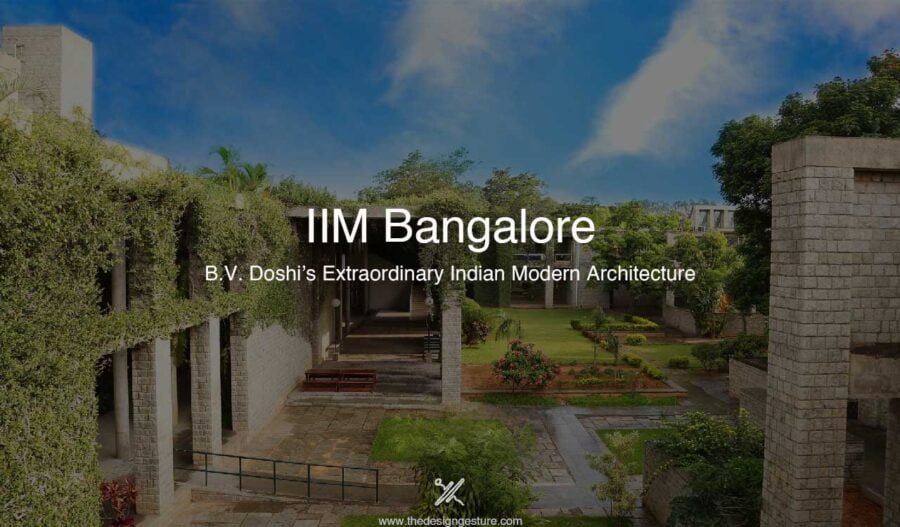One of the greatest innovations, B. V. Doshi’s IIM is a point of discussion in architecture. He was pushed by IIM Bangalore to pursue his philosophy and create modern architecture with an Indian basis. Doshi masterfully integrates his objectives with those of the end user to create a building that is aesthetically pleasing while implementing all design aims.
The IIM Bangalore campus design presents incredibly creative, inventive architects who appreciate life and Indian values just as much as they do architecture. Bangalore is referred to be the Garden City. B.V. Doshi was ordered by management to construct a campus that mirrored the village outside. Doshi did just that—and much more. It is practically possible to view and experience nature inside the classrooms. The goal of the design was to make the IIM campus a center of learning where teachers and pupils could freely converse in a secure environment.
Table of Contents
The Design Approach: Understanding the Plan as a Generator of Space and Interaction
The IIM campus as a distinctive traditional Indian architecture that would effortlessly adapt to the local environment and circumstances. The idea was to represent the ethos, green and alive, of the town. The 54,000 sqm complex is situated on a 100-acre campus in the western hilly part of Bangalore City on Bannerghatta Road. By connecting a network of corridors, courtyards, and external spaces, the renowned architect modeled it on the medieval Mogul city of Fatehpur Sikri.
The orthogonal plan of the IIM Bangalore arranges the functions and is broken up into gardens, rest areas, random encounter spots, and unofficial nodes. As one moves vertically, the staircases that link this hallway to lecture halls, meeting rooms, and other auxiliary spaces act as podiums for people to observe the surrounding scenery. Light, breeze, and vision are all allowed to flow freely within the layout because of this technology. The diagram’s intentional asymmetry is what houses both the generator and the container of life.
An observer’s ability to reveal the Indian Institute of Management Bangalore is necessary for a sequence of spatial exchanges. The general travel sequence—from the open campus to the semi-open corridors, the lush, and ultimately to the more enclosed and protected areas—creates several threshold circumstances. By placing functional spaces in these precise locations within the plan, it becomes easier for them to blend in and complement the overall design. This creates a network of easy connections between work areas and movement areas. The strategy causes layers and ambiguity to appear in the real world.
As these levels become visible, it is possible to observe the diagonal’s emphasis while exploring the complex. B.V. Doshi endeavoured to create a learning atmosphere that was free-flowing and devoid of barriers, such as IIM-B doors, that would limit the students. The four walls of the classrooms do not restrict instruction either; in fact, the corridors’ width is adjusted to promote healthy debates and informal seating. The courtyards and corridors are lessons in rhythm and composition; they exude an Indian cultural and traditional aroma, proving that life, art, and architecture can and must coexist.
Materiality at IIM Bangalore
The construction is made of two materials: concrete and granite. Together with polished and rough Kota stone floors, the structures offer a quiet, neutral backdrop for more dynamic elements like people and trees to live in.
The structure of IIM Bangalore is tactile. As the sun travels, the interior spaces are also in motion. Through the always-shifting light, they discover a lovely expression over time. Mist blows through the hallways in the monsoon, softly catching and releasing sunlight on the granite walls that are now surrounded by robust plants. The lines separating inside from outside are completely dissolved, and what would have been a stark material palette becomes a lush background for the flora.
Here B.V. Doshi had created stunning moments for the guests and residents by adjusting the light to his liking. There is never a dull moment at the IIM complex because of the way the juxtaposition of walls and openings, daylight and shadows, and solids and voids change the space’s presence and look throughout the day and different seasons.
The central courtyard has a transcendent, spiritual aura. Alternatively, one might experience his inner self in the central pergola. Every time, someone is taken aback by the towering corridors. They are frequently left open, occasionally partially obscured by skylights, and occasionally adorned with pergolas, providing a varied spatial experience.
The vegetation matched the ancient stone architecture, as B. V. Doshi had anticipated, and the project was completed in 1983. He accomplished this by including a large number of courtyards and passageways connecting the overall plan. He brings the Bangalore city’s gardens within these courtyards and hallways.
The Doshi-designed campus of IIM Bangalore has not only endured as one of the world’s most prestigious universities, but it has also gradually grown to become a cherished location and a place of pilgrimage for practitioners and students of architecture. The characteristic grey stone structures contrasted with the verdant environs perfectly capture the spirit of the city and the Bangalore Community.
FAQ
1. What are the eligibility criteria for the Post Graduate Programme (PGP) at Indian Institute of Management Bangalore?
Answer: To be eligible for the PGP at IIM Bangalore, candidates must have:
- A bachelor’s degree with at least 50% marks or equivalent CGPA (45% for SC, ST, and PWD categories) from a recognized university.
- Valid CAT (Common Admission Test) scores for Indian candidates. International candidates can apply with GMAT scores.
- Relevant work experience is not mandatory but can be beneficial during the selection process.
2. What is the selection process for the PGP program?
Answer: The selection process for the PGP at IIM Bangalore involves:
- An initial shortlisting based on CAT/GMAT scores.
- Shortlisted candidates are then invited for a Writing Ability Test (WAT) and Personal Interview (PI).
- The final selection is based on a combination of factors including CAT/GMAT score, WAT & PI performance, academic record, work experience, and diversity factors.
3. What is IIM Bangalore fees?
Answer: The IIM Bangalore fees is approximately INR 23-25 lakhs for the entire two-year course. This includes tuition, hostel accommodation, and other academic expenses. Additional costs may include books, personal expenses, and international study opportunities, if any.
4. What are the accommodation options for students?
Answer: IIM Bangalore provides on-campus accommodation for all its students. The campus has well-furnished hostels with single and shared occupancy rooms. The hostels are equipped with essential amenities such as Wi-Fi, common rooms, recreational facilities, and dining options. The campus also ensures a safe and conducive living environment for its students.




